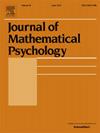Measuring a thought
IF 2.2
4区 心理学
Q2 MATHEMATICS, INTERDISCIPLINARY APPLICATIONS
引用次数: 0
Abstract
Think about a thought. Easy to do but where does the thought come from? How is it created? Can it be measured? If so what in the mind is measured? This presentation describes a method for answering these basic questions. The answers derive from a new experimental method called Directly Measured Stimulus Differences (DMSD) and a new theory of mental measurement, a cybernetic process, for the creation of thought. The ideas of Prime Thought and Prime Mind are introduced.
衡量思想
想想一个想法。这很容易做到,但思想从何而来?它是如何产生的?它能被测量吗?如果可以,那么思想中的什么被测量?本讲座将介绍一种回答这些基本问题的方法。答案来源于一种名为 "直接测量刺激差异(DMSD)"的新实验方法,以及一种新的心理测量理论,即思想产生的控制论过程。介绍了 "主思维 "和 "主心智 "的概念。
本文章由计算机程序翻译,如有差异,请以英文原文为准。
求助全文
约1分钟内获得全文
求助全文
来源期刊

Journal of Mathematical Psychology
医学-数学跨学科应用
CiteScore
3.70
自引率
11.10%
发文量
37
审稿时长
20.2 weeks
期刊介绍:
The Journal of Mathematical Psychology includes articles, monographs and reviews, notes and commentaries, and book reviews in all areas of mathematical psychology. Empirical and theoretical contributions are equally welcome.
Areas of special interest include, but are not limited to, fundamental measurement and psychological process models, such as those based upon neural network or information processing concepts. A partial listing of substantive areas covered include sensation and perception, psychophysics, learning and memory, problem solving, judgment and decision-making, and motivation.
The Journal of Mathematical Psychology is affiliated with the Society for Mathematical Psychology.
Research Areas include:
• Models for sensation and perception, learning, memory and thinking
• Fundamental measurement and scaling
• Decision making
• Neural modeling and networks
• Psychophysics and signal detection
• Neuropsychological theories
• Psycholinguistics
• Motivational dynamics
• Animal behavior
• Psychometric theory
 求助内容:
求助内容: 应助结果提醒方式:
应助结果提醒方式:


